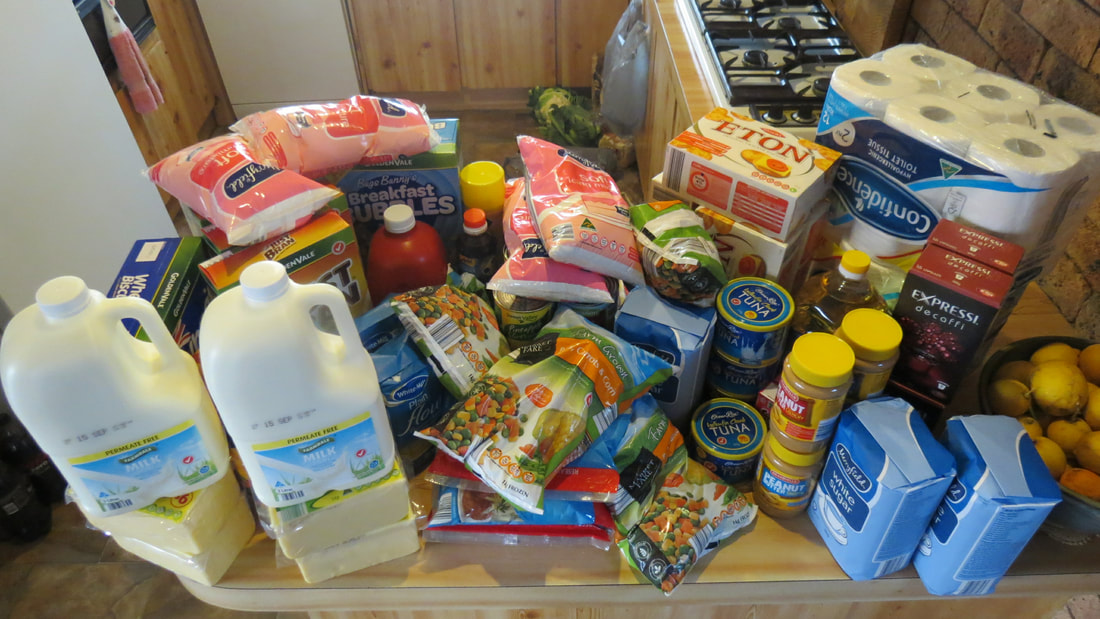|
Today, being the first Friday of the month, is my OAMS day (once a month shopping). I've already done the groceries, I didn't have a lot to buy as you can see from the picture above. I included a few stockpile items this month too, in preparation for the Christmas/New Year craziness.
Since Disaster Struck I've watched our grocery spending like a hawk. We have a very strict grocery budget and I try very hard to not go over it. I need to tell you what is included in our grocery budget, just so you know what's covered by my $320 a month. For my family groceries include: 1. Food 2. Meat 3. Whatever fruits and vegetables we don't grow or get via bartering 4. Cleaning products 5. Basic toiletries and hygeine products. I shop for my family of five adults. Yes, our kids are all grown up but still studying and living (and eating!) at home. I buy meat once every three months, so to be sure I have the "meat money" I put $60 a month aside to use. This is usually more than enough (thanks to Tasman Meats great prices and some good specials at our local butcher). Today I spent $215 at Aldi. For the first time in ages I was able to get everything on the list, including as I mentioned earlier, some stockpile items. The meat money has been put aside and I have $45 left to buy milk (the only grocery item we will actually need) for the next four weeks. So how do I keep the grocery bill low? 1. Meal planningI typically plan our monthly menu a few days before shopping day. I shop for a month so I meal plan for a month. Cheapskates Club members can see what we are eating in the Member's Centre. By doing this, I buy what exactly what we need for the month. Meal planning is a great way to stop "random" shopping, which really causes chaos with a grocery budget. Meal planning also stops the takeaway temptation. Knowing you have something planned for dinner is half the struggle of getting tea on the table. I'm not saying we don't ever have takeaway or eat out but the temptation to do so isn't there if we know we have something delicious already planned. 2. Planning my shopping tripsI shop with a list, a very comprehensive list. It has the item, size, quantity and the last price I paid on it. I write my shopping list in order of stores and I try to write each stores list according to the layout. My shopping list keeps me focussed on the task at hand: getting the groceries. I do one big shop on the first Friday of each month, then buy milk and cream and any fruit and veg top-ups once a week. That's it. I stay away from supermarkets until shopping day. 3. Shop the salesWhen I'm writing my shopping list, I always do it with the Coles, Woolworths and Aldi websites open. This is probably the biggest way we save on groceries; having the online catalogues open lets me compare prices between the supermarkets quickly and easily. This means I can jot items down under the supermarket they are cheapest. 4. Build a stockpileI practice the buy-ahead principle as much as possible, in order to create a stockpile and build up our pantry with items we will use later. I aim to have a twelve week supply of our basic grocery items at all times. I don't have stuff stashed everywhere and I don't stockpile things we rarely use. I do use the grocery slush fund to stockpile things we use a lot of when they are on a super great sale, especially if they are the pricier items like shampoo, conditioner, dried fruit, meat and so on. When I'm creating our meal plan I shop the pantry, fridge and freezer and use the groceries we have on hand. This way I always pay the lowest possible price for groceries. 5. Ditch brand loyaltiesI am not a brand snob. Flour is flour, sugar is sugar. Most basic grocery items available in Australia are excellent quality regardless of the price. I try to buy Australian owned, then Australian made when they fit within my grocery budget. There are times I'll have something on my shopping list that isn't on sale. When that happens I buy the best value brand I can find. If the cheapest brand is the store brand, then that's what we buy. I could write a lot more about how I keep the grocery bill low, but for today these five points give you the general idea. Everyone is different, every family's needs and wants are different and that is fine. You may live hours from supermarkets or you may be catering to special dietary needs. Your grocery budget doesn't have to be the same as anyone else's, you determine what meets your needs. If you're struggling with cutting the cost of groceries, implement these five simple steps. I guarantee you will save money and if nothing else, you'll have your grocery spending under control. You can work on getting it as low as you want it to be then.
0 Comments
Your comment will be posted after it is approved.
Leave a Reply. |
Archives
April 2020
Categories
All
|

 RSS Feed
RSS Feed